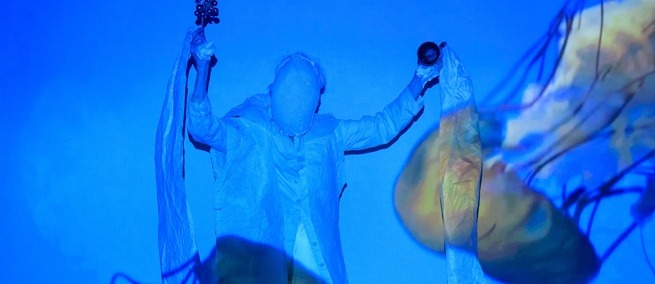
“We come from the sea. We have memories of it,” intones Joan Jonas in the latest work of her 50-year career. “Moving Off The Land. Ocean—Sketches and Notes” reminds us—through text, movement, video, and music—that the salt in our blood was once seawater. This masterful piece made its United States premiere at Danspace Project in New York. “Moving Off The Land” originated with a performance in Kochi, India in 2016, and has continued to evolve with support from the TBA21-Academy (a project bringing together artists, thinkers, and researchers concerned with the most urgent ecological, social, and economic issues). Jonas has been developing "Moving Off The Land" most recently with input from David Gruber, a biology and environmental science professor at Baruch College, who specializes in the microbial ecology of coral reefs and fluorescent proteins found there. Before presenting “Moving Off The Land” in New York, Jonas performed it in Vienna, in Reykjavik, Iceland (with accompaniment from composer and violinist María Huld Markan Sigfúsdóttir), and in May 2018 at the Tate Modern where a survey exhibition of her work was on view.
Joan Jonas is a pioneer of video, performance, and installation art. She represented the United States in the 2015 Venice Biennale. She is a professor emerita in the MIT Program in Art, Culture, and Technology. Jonas has just been awarded the 2018 Kyoto Prize in Art, a major international award, for creating “a new form of artistic expression in the early 1970s by integrating performance art with video. Through labyrinth-like works that lead audiences to diverse interpretations, she hands down the legacy of 1960s avant-garde art by developing it into a postmodern framework, profoundly impacting artists of later generations.” Science & Film spoke with Jonas at her studio in SoHo on June 27, after her Danspace performance of “Moving Off The Land.”
Science & Film: Did you develop any sort of kinship with sea creatures while conceiving “Moving Off The Land”?
Joan Jonas: Oh, definitely. Particularly the last three months working on this final version. The first version in Kochi, India was more like a lecture demonstration, and while I had some of the projected images I did not have all of them. I just began working with David Gruber, which is where I got that luminescent underwater footage. Since 2014 I’ve been filming sea creatures in aquariums. My natural way of working is to get into the subject more deeply over time, so the material gradually grew. And then—actually I never had this experience before—in interacting with the projections I really did feel viscerally closer to the whole subject.
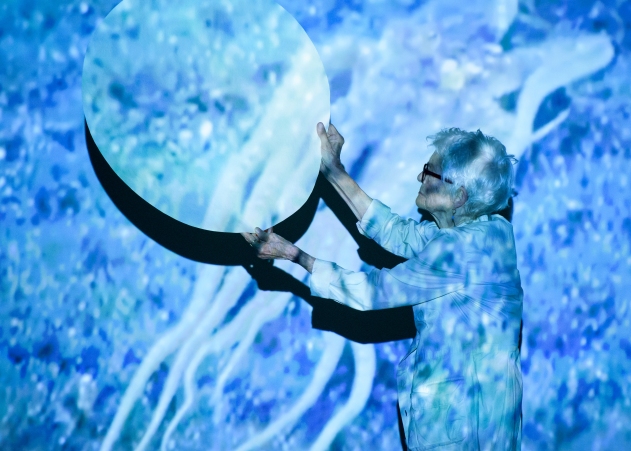
Danspace Project, NY, 2018. Photo: Ian Douglas
S&F: How long did you spend developing this work?
JJ: The first version I just spent a month on the actual performance, which included editing pre-recorded video. And then, when I did it again in Vienna and then in Iceland, each time I’d spend another month on it. I was trying to make it a little bit better each time. It was something I was doing at the same time that I was doing other major projects; it was a parallel, slightly less concentrated on, project. But finally in the last year I have spent more time working on it, especially since I decided that I wanted to work with David Gruber. So now after this performance I’ll focus on it again with him and turn it into an installation. I’d like to do the performance again but where and how I don’t know. The installation will be in Venice where TBA21 has a church that they’ve leased.
S&F: That’s amazing. How is it working with David Gruber?
JJ: Oh he’s very nice, he’s great. I’m just beginning to work with him. He’s a fascinating and learned person. He’s very easy to talk to and to interact with.
S&F. How did you two connect?
JJ: Through TBA21, which is an organization started by Francesca von Habsburg. TBA21 commissions artists and has a curator for three years [who assigns the commissions]; Ute Meta Bauer was the curator who invited me to begin this in Kochi, India with a performance about oceans. I made a conscious decision—because I was working on other subjects—to do this because I thought it was an important issue.
S&F: What was it like filming in aquariums?
JJ: Well, interesting. Aquariums can be very depressing. Of course some of them are better than others. But there were some great animals, like the cuttlefish. The Boston Aquarium I really like. Except for the luminescent underwater footage and the footage that was shot in Jamaica, all the fish footage was from aquariums.
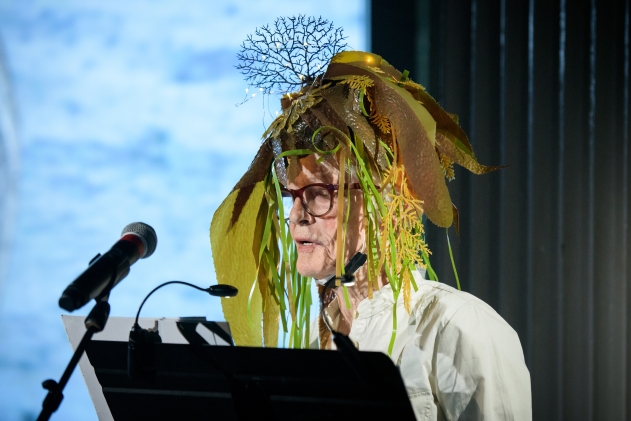
Danspace Project, NY, 2018. Photo: Ian Douglas
S&F: Why did you want to film in Jamaica?
JJ: I went to Jamaica because I wanted to film myself swimming and also I wanted to shoot underwater. But it was very cloudy and stormy when I got there with Cynthia [Beatt], so it was only toward the end that we could film. But Francesca von Habsburg was very generous and shared her shots swimming through the corals with me. I also wanted to visit the foundation that Francesca has established there, and talk to local fisherman.
S&F: Another filmmaker whose work you include is Jean Painlevé, one of the pioneers of underwater filmmaking. How did you find out about him?
JJ: I’ve known about him for years. I taught this class at MIT called “Action: Archeology in the Deep Sea,” and that was, I don’t know how many years ago, eight years ago or so. And I showed my students Painlevé’s work. I work with subject matter in my classes. We also read Moby Dick. I’d read it before, but I used it in the class. So I had a kind of start—I think that’s why Ute [from TBA21] asked me actually.
S&F: I’m sort of obsessed with Painlevé and have shown his work before. I think he had a really interesting approach to working with sea creatures.
JJ: He did. He animated them. And played music, and they sort of danced.
S&F: Yeah, exactly.
JJ: He anthropomorphized them.
S&F: I wonder, thinking about your work, if anthropomorphizing animals was something you were trying to stay away from or engage with?
JJ: I didn’t want to do that. But, we are close to fish, other sea creatures, and to animals in general. There is a lot of research into human animal communications, and we are closer than we ever realized to some of these animals.
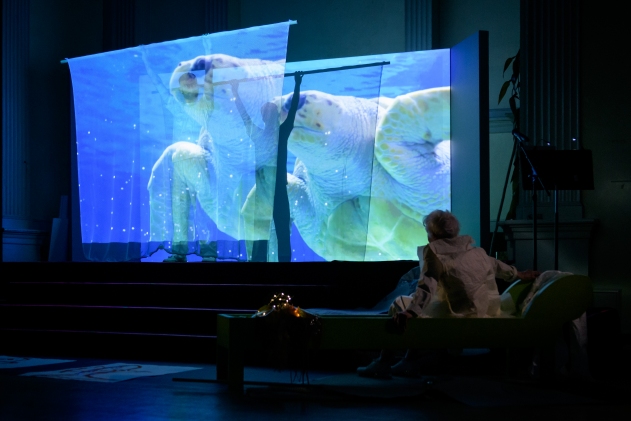
Danspace Project, NY, 2018. Photo: Ian Douglas
S&F: In terms of text, you include words by Rachel Carson, Sylvia Earle, and some other great sources. How did you make those decisions?
JJ: I read Rachel Carson’s Silent Spring when it came out in the 1960s, and it was a significant early text on the environment. About a year and a half ago I started re-reading her books and they are so beautiful. I decided that I wanted to make the text [in “Moving Off The Land”] more poetic. Carson is a science writer who can write poetically, so I wanted to include her descriptions. Some of the statistics in “Moving Off The Land” come from TV shows and radio. I am constantly looking for material for a piece even when I am not working directly on it.
S&F: Do you see the piece as conveying some kind of message, or moral?
JJ: Well there is a message, but I don’t think I can express it solely in words. A lot of people aren’t exposed to some of these things about the ocean. It is an important issue but I don’t want to be didactic.
S&F: The way that you read texts during the piece, it is sort of like a fairy tale, or a bedtime story.
JJ: I thought, how can I deal with this subject? And what do I always do? I deal with myth, so that was how I began to think about it. I looked at this very prevalent myth of the mermaid and at other myths, and then at reality as well, juxtaposing the two. Then I read The Soul of an Octopus. It’s really great, and it’s based on real research so it’s a blend of myth and reality.
S&F: Animals in particular are often used as a substitute for humans in fairytales, in which there is some sort of moral about how you should be in the world. But the way that you integrate facts in “Moving Off The Land” seems to ground the fairytale element.
JJ: I am, yeah. In the beginning, I did include an Italo Calvino story about a fish family who had just come out of the sea and one of them went back and so on, but I took it out because it was too much—too many words. There were a lot of words before this version. I cut it down quite a bit, because I wanted there to be less spoken text and more performance.
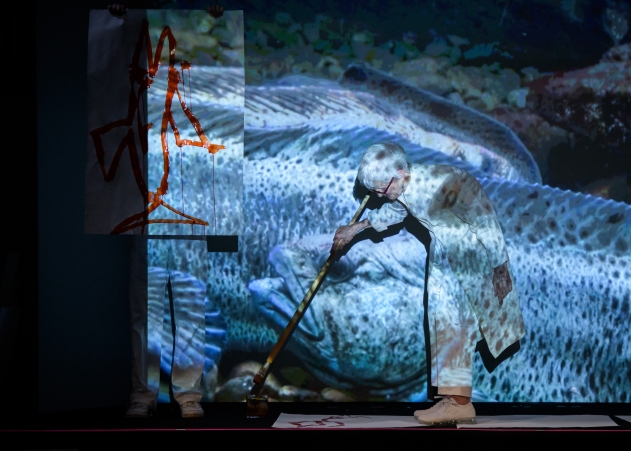
Danspace Project, NY, 2018. Photo: Ian Douglas
S&F: And did you imagine that this project would become an installation?
JJ: A lot of my things do. I didn’t think about it until maybe a year ago when TBA21 said they wanted to commission me. The first performance was not exactly a commission. Now it’s a commission to go on working on it.
S&F: In what ways do you see “Moving Off The Land” as different from your other work?
JJ: The movement is choreographed in a slightly different way in relation to the presence of the fish in the projections. Although there is movement in my other pieces, this one has more. I’m going back to the way I worked with material in the Venice Biennale piece. I wanted to continue working with the image in that way—manipulating the content without special effects.
S&F: I couldn’t tell what you were doing with the circular scrim that you used during the performance. It was almost like a microscope on the video.
JJ: I was just standing in front of the projection with different surfaces. You couldn’t tell what I was doing?
S&F: I didn’t know. When the circle was in front of the screen, it did look like the image behind it was magnified, and I couldn’t tell if it was just because the circle was closer to whatever was projecting, or…?
JJ: It’s focusing on one part and magnifying it a little bit. The closer you get to the projector the bigger it gets.
S&F: It was very simple [laughs], but also very cool. Had you done that before?
JJ: Mhm. I have. Quite a bit.
S&F: In much of your work you present animals that have, so far as I’m aware, been land-based animals. Is this the first time you’ve worked with sea creatures?
JJ: I had one room in the Venice Biennale piece about fish. I was obsessed with drawing fish for a few years, and so I included that in the Venice project. And then “Moving Off The Land” kind of evolved from that section of the piece.
S&F: What do you like about drawing fish?
JJ: Well, I draw a lot. In 2014, I decided that I was going to draw 100 fish and make an installation of the drawings. It was when I was going to Japan for a residency at CCA. I had found a book about fish, and I was thinking about how the Japanese eat so many fish—basically that’s what came into my mind.
S&F: In some of your pieces you wear masks of animals. That wasn’t in “Moving Off The Land” per se, but you do wear a great headdress at one point.
JJ: I was thinking about the idea of mermaids, and where that came from. Why it’s such a big myth in our culture, in every culture.
S&F: What did you realize?
JJ: As I said in the piece, maybe there’s a memory of some sort.
S&F: That’s so beautiful.
JJ: [chuckles]
S&F: Ikue Mori’s sound was amazing.
JJ: Yeah that was nice.
S&F: Was that part of your conception of this piece from the beginning?
JJ: No, no. She just came in on this. I did this piece at the Tate right before New York. I started working on it again. When I was in Iceland I worked with an Icelandic composer, María Huld Markan Sigfúsdóttir, who played the violin. Then for this I needed something slightly different. I heard about Ikue Mori and I thought she’d be perfect.
S&F: Yeah, she was great. You’ve worked a lot with the musician Jason Moran, why didn't you this time?
JJ: He actually couldn’t [for this piece]. He’s getting very busy. And also I didn’t want a piano, actually. I didn’t think it would be appropriate.
S&F: Do you like collaborating with musicians?
JJ: I do. Especially since I’ve been working with Jason. I collaborated before, but not steadily the way I’ve been working with Jason.
S&F: At what point do you usually bring in Jason or said musician?
JJ: I brought Jason in at the very beginning of that project I did for Dia: Beacon. Ikue, she came late in this project. It depends.
S&F: It was such a funny visual contrast between the two of you. She just sits there and these amazing things come out.
JJ: That’s true. She’s not dramatic.
S&F: So the next thing you’re working on is the installation of “Moving Off The Land”?
JJ: Yes, I’m developing it with David Gruber. It will be a different iteration of the piece.
S&F: And you just won this big Kyoto Prize. Congratulations.
JJ: Oh thank you. It’s a little overwhelming. It’s great.
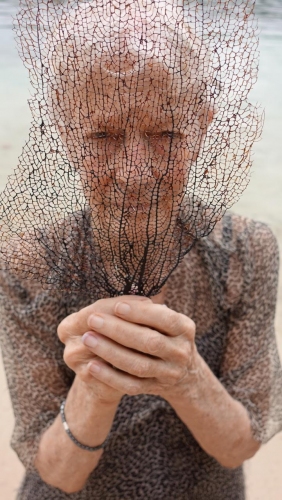
Joan Jonas in Jamaica. Photo: Cynthia Beatt
“Moving Off The Land” is conceived and directed by Joan Jonas. It was presented at Danspace Project in New York from June 14-16, performed by Jonas and Francesco Migliaccio. Ikue Mori did the music. Video was by Jonas, with editing help from David Sherman. Additional footage was filmed by Cynthia Beatt and Francesca von Habsburg, and fluorescent recordings by David Gruber. Jean Painlevé’s THE OCTOPUS (1928) was also included. Jonas read text by Rachel Carson, Sy Montgomery, Peter Godfrey-Smith, Herman Melville, Emily Dickinson, and T.S. Eliot.
TOPICS